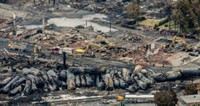Advertisement
Grab your lab coat. Let's get started
Welcome!
Welcome!
Create an account below to get 6 C&EN articles per month, receive newsletters and more - all free.
It seems this is your first time logging in online. Please enter the following information to continue.
As an ACS member you automatically get access to this site. All we need is few more details to create your reading experience.
Not you? Sign in with a different account.
Not you? Sign in with a different account.
ERROR 1
ERROR 1
ERROR 2
ERROR 2
ERROR 2
ERROR 2
ERROR 2
Password and Confirm password must match.
If you have an ACS member number, please enter it here so we can link this account to your membership. (optional)
ERROR 2
ACS values your privacy. By submitting your information, you are gaining access to C&EN and subscribing to our weekly newsletter. We use the information you provide to make your reading experience better, and we will never sell your data to third party members.
Safety
Safety Derailed
After nine deaths, inspectors seek causes of deadly chlorine spill
by MARC REISCH AND JEFF JOHNSON
January 17, 2005
| A version of this story appeared in
Volume 83, Issue 3
TRANSPORTATION
A train wreck and subsequent chlorine spill have again raised questions about the safe transport of hazardous chemicals.
Just days after arriving at the site of the wreck in Graniteville, S.C., National Transportation Safety Board (NTSB) investigators determined that an incorrectly set track switch on the morning of Jan. 6 sent a 42-car Norfolk Southern train on a collision course with a parked train.
Questions remain about why the switch was incorrectly set by a train work crew. Terrorism is not suspected. Questions also remain about why a tank car designed to safely transport chlorine suffered a puncture and leaked its contents. The accident killed nine people, sent more than 250 to area hospitals, and forced the evacuation of 5,400 people from their homes within a 1-mile radius.
In the wreck, at a rail siding outside an Avondale Mills denim textile plant, 16 cars derailed. One tank car, leased by Olin Corp., suffered a gash in its side and leaked the deadly greenish-yellow gas.
Of the nine people who died in the accident, eight succumbed to the gas; the train engineer died from wounds sustained in the crash. Of the eight chlorine victims, six were found in the mill, one in a vehicle, and another in a home nearby.
Six days later, workers had applied a patch to the leaking tank car and removed the contents. Only half of those forced to evacuate had been allowed back to their homes.
Last March, investigators questioned the integrity of the U.S. tank car fleet in an NTSB report on a Canadian Pacific freight train that derailed three years ago. In that incident, five ammonia tank cars ruptured, releasing the poisonous gas. Steel used in the tank cars' construction came under suspicion. All five, manufactured before 1989, were made with steel that becomes brittle at low temperatures.
Cars made after 1989 use a heat-treating process that lowers the temperature at which steel becomes brittle. The chlorine car that leaked in South Carolina was made after 1989.
Heat-treated steel was a great improvement in tanker safety, says Kathleen A. Shaver, president of the Chlorine Institute. "We continue to work with shippers, railroads, regulators, and tank car builders to improve tank car design," she adds.
Building a chlorine plant closer to the point of use–as Ashta Chemicals just announced it is doing at a Great Lakes Chemical plant in El Dorado, Ark., where chlorine will be used to make bromine–is not the answer to preventing accidents while shipping hazardous chemicals, Shaver maintains. "A one-size solution won&'t fit all cases," she adds.
The South Carolina accident resurrected calls for a ban on transport of hazardous chemicals through the District of Columbia. In a letter to outgoing Homeland Security Secretary Tom Ridge, Rep. Eleanor Holmes Norton (D-D.C.) warned that the accident is a small-scale demonstration of what could happen in the District from a terrorist attack on a similar tank car. Two D.C. legislators say they plan to reintroduce legislation soon that would reroute hazardous shipments around the Capitol.
"Whether it's an accident or an al Qaeda attack, we need to make the shipments of deadly chemicals more secure," says Rep. Edward J. Markey (D-Mass.), a senior member of the House Homeland Security Committee.




Join the conversation
Contact the reporter
Submit a Letter to the Editor for publication
Engage with us on Twitter